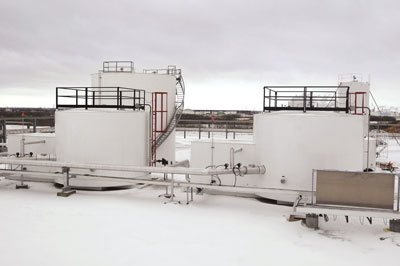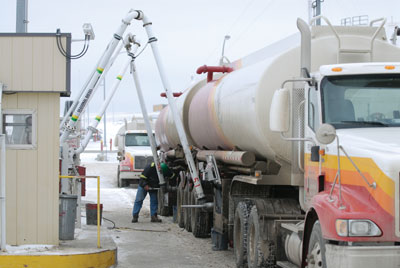
Features
Biodiesel
Bioenergy
Cold weather does not put the freeze on biodiesel
Canada’s largest cold-weather demonstration of renewable diesel has shown that low levels of canola-derived renewable diesel blended with petroleum diesel will work. It can be blended, distributed and used without problems, even in a bitter Alberta winter, using normal commercial facilities.
March 17, 2010 By Carolyn King
Canada’s largest cold-weather demonstration of renewable diesel has shown that low levels of canola-derived renewable diesel blended with petroleum diesel will work. It can be blended, distributed and used without problems, even in a bitter Alberta winter, using normal commercial facilities.

|
| Storage tanks for neat renewable diesel used during the Alberta on-road demonstration. (Photos courtesy of Climate Change Central)
|
The demonstration was sparked by the Canadian Government’s announcement in December 2006 that it intended to develop a standard requiring a portion of renewable fuel in the Canadian fuel supply. For diesel, the standard will be an average two percent renewable fuel content by 2012. “It was decided that, before this standard could go ahead, we would need some testing and/or demonstration projects that answer stakeholders’ questions, in particular around cold weather operability of renewable diesel blends, such as: Is the standard technically feasible? And what happens at a commercial scale?” says John Rilett, vice president of Climate Change Central.

|
|
| The vehicles using renewable diesel in the demonstration did not have any problems.
|
As an independent, not-for-profit organization, Climate Change Central was chosen to manage a two-phase project to answer these questions. It brought together stakeholders ranging from feedstock suppliers, like the Canola Council of Canada, to fuel producers, blenders and distributors, trucking companies, engine manufacturers, vehicle manufacturers, and governments.
Rilett says, “One of the successes of this project is that we were able to get everybody around the table to participate. This ultimately moves the debate much further down the road.”
The project started in 2006 with a laboratory phase. Various renewable diesel fuels were tested to see how well they met the Canadian General Standards Board (CGSB) specifications for quality and cold-weather performance, such as cloud point. The cloud point is the temperature at which a liquid fuel starts to get a cloudy appearance, indicating that it is beginning to change from a liquid to a solid. Cloud points for biodiesel fuels occur at higher temperatures than for petroleum diesel, so cold weather performance is more of an issue for biodiesel.
The project analyzed renewable fuels alone and in blends with ultra-low sulphur diesel (ULSD). The renewable fuels were made from canola, soybeans, tallow, yellow grease and/or palm feedstocks. Eight were fatty acid methyl ester fuels, commonly called biodiesel, and three were hydrogenation-derived renewable diesel (HDRD). The HDRD fuels are made from the same feedstocks as biodiesel, but they are created through a different process that results in a product very similar to petroleum diesel. The HDRD fuels are a relatively recent development, and there is a great deal of interest in their potential.
Of the eight biodiesel fuels, the canola biodiesel had the best cold weather performance characteristics. The HDRD fuels had characteristics similar to petroleum diesel.
The second phase of the project was the real-world demonstration, which ran from December 2007 to September 2008 in Alberta. Renewable fuels were blended with ULSD, and ultra-low sulphur kerosene was added as required to meet the CGSB cloud point standards. The project used blends with a two percent renewable content from December to mid-April and a five percent renewable content from mid-April to September. The five percent blends were included because the federal regulation will be based on a fuel company’s annual volume of diesel produced or imported. So a company might choose to have a portion of its total supply with less than two percent renewable content and a portion with more than two percent.
The demonstration involved 75 commercial vehicles such as long-haul transport trucks, school buses, and oilfield service-hauling vehicles. Thirty of the vehicles used HDRD blends, 29 used biodiesel blends, and 16 used ULSD alone. The HDRD fuel was made from a combination of tallow, palm and canola feedstocks. The biodiesel in the two percent blends was from canola feedstock, and in the five percent blends it was from 75 percent canola/25 percent tallow feedstocks.
Practical results
The demonstration’s results answered key questions for stakeholders.
Is the renewable diesel standard technically feasible? Rilett responds, “The project showed it is totally feasible to create blends of renewable diesel and petroleum diesel that meet the CGSB cloud point requirements for winter operation.”
Can it work at a commercial scale? He answers, “We showed we could store, blend and get the fuel out the door in a commercial scale blending facility operating at the kinds of speeds and volumes expected at a commercial scale. We were able to distribute it through the normal fuel distribution chain with no special measures taken, and the fuel maintained its quality; it met all standards required of it.”
Is it feasible in cold conditions? All aspects of the demonstration operated smoothly in temperatures that reached as low as -44 degrees C. “We didn’t have any problems. For instance, we didn’t have any failures with vehicles having trouble with the fuel or blocked filters or what have you,” notes Rilett.
Including HDRD fuels in the demonstration means that the project not only provides information for the current renewable diesel fuels but for ones that could be coming in the near future. Rilett says, “As far as I know, we were the first demonstration project in North America to use HDRD.”
The demonstration also yielded practical information on the use of ultra-low sulphur kerosene to adjust cloud points. Rilett explains, “We believe our project is the first and possibly only project to date to temperature-correct the cloud point in the base fuels using ultra-low sulphur kerosene, which is the standard in the industry for getting fuel to work at colder temperatures. The demonstration showed that there are a few weeks in the coldest part of the year where you need a fair bit of temperature correction to meet the standard, but then the rest of the year, you don’t. Hopefully that information will help people design systems to better manage that issue.” For example, a company could choose to provide diesel with no renewable content in the very coldest part of the winter, and then use a blend with more than two percent renewable content when warmer temperatures remove cloud point concerns.
| Good news for farmers For farmers, the demonstration confirms that renewable diesel from agricultural feedstocks works at the low level blends required in the Canadian renewable fuels standard. According to John Rilett of Climate Change Central, that standard equates to about 600 million litres of renewable diesel nationwide, which is equal to an additional market of about the same volume of plant oil or animal fat feedstock. In terms of canola, that would be about 1.4 million tonnes of canola seed. Rilett sees further opportunities ahead for Canadian crop producers. “Canola holds a lot of promise as an energy crop in the next three- to 10-year horizon. Then I think you’ll probably see new opportunities evolving for farmers. It may be canola oil for food and energy, and another crop in their rotation that is in there for energy purposes.” |
| Renewable diesel and the environment John Rilett of Climate Change Central outlines the environmental advantages of including some renewable diesel in Canada’s diesel supply. “From a greenhouse gas standpoint, biodiesel is much less carbon-intensive on a lifecycle basis than standard petroleum diesel, usually in the range of 60 to 70 percent less if you compare a litre of biodiesel to a litre of petroleum diesel on a lifecycle basis. Even though the renewable fuel standard is only two percent, when you roll that out across Canada with the roughly 500 or 600 million litres of renewable diesel that requires every year, it makes a significant contribution to reducing carbon emissions from the transport sector.” “The second advantage is that biodiesel quite often improves tailpipe emissions from a number of types of diesel engines. So when a bus or truck goes down the street past you, you get less particulate matter, less sulphur and those sorts of things coming out of the tailpipe.” |